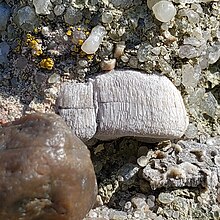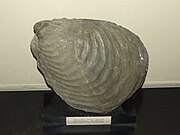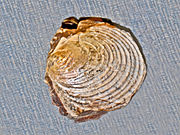Inoceramus
| Inoceramus | |
|---|---|

| |
| Scientific classification | |
| Kingdom: | Animalia |
| Phylum: | Mollusca |
| Class: | Bivalvia |
| Order: | Pteriida |
| Family: | †Inoceramidae |
| Genus: | †Inoceramus Sowerby, 1814 |
| Species | |
|
See text | |
Inoceramus (Greek: translation "strong pot") is an extinct genus of fossil marine pteriomorphian bivalves that superficially resembled the related winged pearly oysters of the extant genus Pteria. They lived from the Early Jurassic to latest Cretaceous.[1][2]
Taxonomy[]
The taxonomy of the inoceramids is disputed, with genera such as Platyceramus sometimes classified as subgenus within Inoceramus. Also the number of valid species in this genus is disputed.
Description[]


Inoceramids had thick shells composed of "prisms" of calcite deposited perpendicular to the surface, and unweathered fossils commonly preserve the mother-of-pearl luster the shells had in life.[3] Most species have prominent growth lines which appear as raised semicircles concentric to the growing edge of the shell. Paleontologists suggest that the giant size of some species was an adaptation for life in the murky bottom waters, with a correspondingly large gill area that would have allowed the animal to survive in oxygen-deficient waters.[3]
Selected species[]
- †I. aequicostatus Voronetz 1937
- †I. albertensis McLearn 1926
- †I. altifluminis McLearn 1943
- †I. americanus Walaszczyk & Cobban 2006
- †I. andinus Wilckens 1907
- †I. anglicus Woods 1911
- †I. anilis Pcelinceva 1962
- †I. anomalus Heine 1929
- †I. anomiaeformis Feruglio 1936
- †I. apicalis Woods 1912
- †I. arvanus Stephenson 1953
- †I. bellvuensis
- †I. biformis Tuomey, 1854
- †I. brownei Marwick 1953
- †I. carsoni McCoy 1865
- †I. comancheanus
- †I. constellatus Woods 1904
- †I. corpulentus McLearn 1926
- †I. coulthardi McLearn 1926
- †I. cuvieri Sowerby 1814
- †I. dakotensis
- †I. dominguesi Maury 1930
- †I. dowlingi McLearn 1931
- †I. dunveganensis McLearn 1926
- †I. elburzensis Fantini 1966
- †I. everesti Oppel 1862
- †I. fibrosus Meek & Hayden 1857
- †I. formosulus Voronetz 1937
- †I. fragilis Haal & Meek 1856
- †I. frechi Flegel 1905
- †I. galoi Boehm 1907
- †I. gibbosus
- †I. ginterensis Pergament 1966
- †I. glacierensis Walaszczyk & Cobban 2006
- †I. haast Hochstetter 1863
- †I. howelli White 1876
- †I. incelebratus Pergament 1966
- †I. inconditus Marwick 1953
- †I. kystatymensis Koschelkina 1960
- †I. lamarcki Parkinson 1819
- †I. lateris Rossi de Gargia & Camacho 1965
- †I. mesabiensis Bergquist 1944
- †I. morii Hayami 1959
- †I. multiformis Pergament 1971
- †I. mytiliformis Fantini 1966
- †I. nipponicus Nagao & Matsumoto 1939
- †I. perplexus
- †I. pictus
- †I. pontoni McLearn 1926
- †I. porrectus Voronetz 1937
- †I. prefragilis Stephenson 1952
- †I. proximus'' Tuomey, 1854
- †I. pseudolucifer Afitsky 1967
- †I. quenstedti Pcelinceva 1933
- †I. robertsoni Walaszczyk & Cobban 2006
- †I. saskatchewanensis Warren 1934
- †I. selwyni McLearn 1926
- †I. sokolovi Walaszczyk & Cobban 2006
- †I. steinmanni Wilckens 1907
- †I. subdepressus Meek & Hayden 1861
- †I. tenuirostratus Meek & Hayden 1862
- †I. triangularis'' Tuomey, 1854
- †I. undabundus Meek & Hayden 1862
- †I. ussuriensis Voronetz 1937
Distribution[]

Species of Inoceramus had a worldwide distribution during the Cretaceous and Jurassic periods (from 189.6 to 66.043 Ma).[1] Many examples are found in the Pierre Shale of the Western Interior Seaway in North America. Inoceramus can also be found abundantly in the Cretaceous Gault Clay that underlies London. Other locations for this fossil include Vancouver Island,[3] British Columbia, Colombia (Hiló Formation, Tolima and La Frontera Formation, Boyacá, Cundinamarca and Huila),[4] Spain, France, Germany, Afghanistan, Albania, Algeria, Angola, Antarctica, Argentina, Australia, Austria, Brazil, Bulgaria, Canada (Alberta, Northwest Territories, Nunavut, Saskatchewan, Yukon), Chile, China, Cuba, the Czech Republic, Denmark, Ecuador, Egypt, Greenland, Hungary, India, Indian Ocean, Iran, Italy, Jamaica, Japan, Jordan, Kenya, Libya, Madagascar, Mexico, Morocco, Mozambique, Nepal, New Caledonia, New Zealand, Nigeria, Papua New Guinea, Peru, Poland, the Russian Federation, Saudi Arabia, Serbia and Montenegro, South Africa, Sweden, Switzerland, Tunisia, Turkey, Turkmenistan, the United Kingdom, United States (Alabama, Alaska, Arizona, Arkansas, California, Colorado, Delaware, Idaho, Iowa, Kansas, Maryland, Minnesota, Mississippi, Montana, Nebraska, New Jersey, New Mexico, North Carolina, North Dakota, Oregon, South Carolina, South Dakota, Tennessee, Texas, Utah, Washington, Wyoming), and Venezuela.[1]
Gallery[]

Inoceramus from the Cretaceous of South Dakota
Inoceramus proximus

Inoceramus cuvieri

Inoceramus vancouverensis
Inoceramus hobetsensis
References[]
- ^ a b c Inoceramus at Fossilworks.org
- ^ Ward et al., "Ammonite and inoceramid bivalve extinction patterns in Cretaceous/Tertiary boundary sections of the Biscay region (southwestern France, northern Spain)", Geology, 1991
- ^ a b c Ludvigsen & Beard, 1997, pp. 102–103
- ^ Acosta & Ulloa, 2001, p. 41
Bibliography[]
- Ludvigsen, Rolf; Beard, Graham (1997). West Coast Fossils: A Guide to the Ancient Life of Vancouver Island. pp. 102–103. ISBN 9781550171792.
- Acosta Garay, Jorge; Ulloa Melo, Carlos E (2001). Geología de la Plancha 208 Villeta - 1:100,000 (PDF). INGEOMINAS. pp. 1–84. Archived from the original (PDF) on 24 March 2017. Retrieved 4 April 2017.
Further reading[]
- Kennedy, W.J.; Kauffman, E.G.; Klinger, H.C. (1973). "Upper Cretaceous Invertebrate Faunas from Durban, South Africa". Geological Society of South Africa Transactions. 76 (2): 95–111.
- Klinger, H.C.; Kennedy, W.J. (1980). "Upper Cretaceous ammonites and inoceramids from the off-shore Alphard Group of South Africa". South African Museum. 82 (7): 293–320.
- Gebhardt, H. (2001). "Inoceramids, Didymotis and ammonites from the Nkalagu Formation type locakity (late Turonian to Coniacian, southern Nigeria): biostratigraphy and palaeoecologic implications". Neues Jahrbuch für Geologie und Paläontologie, Monatshefte. 2001 (4): 193–212. doi:10.1127/njgpm/2001/2001/193.
- El Qot, G.M. (2006). "Late Cretaceous macrofossils from Sinai, Egypt". Beringeria. 36: 3–163.
External links[]
| Wikimedia Commons has media related to Inoceramus. |
- Inoceramidae
- Prehistoric bivalve genera
- Jurassic bivalves
- Cretaceous bivalves
- Mesozoic Antarctica
- Mesozoic animals of Africa
- Mesozoic animals of Asia
- Mesozoic animals of Europe
- Prehistoric bivalves of North America
- Mesozoic animals of South America
- Mesozoic Chile
- Cretaceous Argentina
- Cretaceous Brazil
- Cretaceous Colombia
- Cretaceous Ecuador
- Cretaceous Peru
- Cretaceous Venezuela
- Early Jurassic genus first appearances
- Toarcian genera
- Aalenian genera
- Bajocian genera
- Bathonian genera
- Callovian genera
- Oxfordian genera
- Kimmeridgian genera
- Tithonian genera
- Berriasian genera
- Valanginian genera
- Hauterivian genera
- Barremian genera
- Aptian genera
- Albian genera
- Cenomanian genera
- Turonian genera
- Coniacian genera
- Santonian genera
- Campanian genera
- Maastrichtian genera
- Late Cretaceous genus extinctions
- Fossil taxa described in 1814
- Fossils of Serbia




